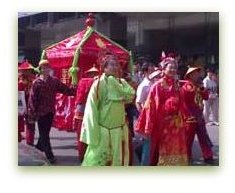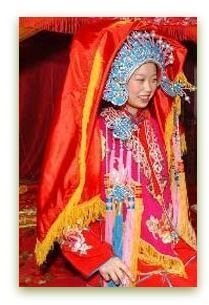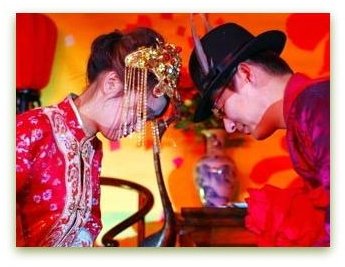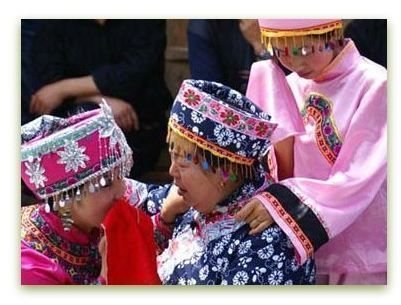The Meaning of a Traditional Chinese Wedding
Chinese Culture
The Chinese are a people of long-standing traditions even in the world of the information age. Technology and tradition blend together on some culture fronts but in certain aspects the main traditions that have been carried for over 2,000 years remain in modern-day life.
One area in which there are still long-standing customs is a couple’s marriage. The days of land holding and dowries may not be common but the ceremony building and celebration history stays much the same as it did years ago. Each aspect of a couple’s joining together holds value, and that is where the meaning of a traditional Chinese wedding becomes important for those involved.
Proposal and Courting
In ancient Chinese culture, unlike that of America, the first step in two people getting married was not dating. Dating in the modern view was not acceptable unless intent was first made between families. Neither the male nor female looking to date were allowed to start the process but rather a third party would first approach each family to propose that the couple start the dating process.
The third party would traditionally be chosen by the young man’s family when looking for a good match. The male’s family would send someone on their behalf to speak with the young woman’s family and negotiate terms for courting to begin. The reason that this was done was to ensure that the couple created would honor both families by making each family stronger through marriage and children. Young people were also considered too foolhardy to make smart choices when it came to building a family of their own and bringing honor to their living families and ancestors.
If the young woman’s family agreed to the relationship, they would then give the third party their daughter’s birth record to take back to the young man’s family. Each family would need this information to build the Chinese zodiac chart and learn if each person would be compatible in marriage. If the couple were compatible and each family accepted gifts given, then they would move forward with the relationship. After this process was completed, the wedding could then be planned.
Pre-Wedding Traditions
Once the couple passed the proposal and courting period they would then move on to the pre-wedding stage. In this stage, both the bride-to-be and groom-to-be were kept separated.
The bride-to-be would be put into seclusion in her own home with her closest girlfriends and female relatives. They would then spend time mourning the loss of the bride-to-be and rail against the third party who started the process. The bride-to-be would remain in this seclusion until her wedding day.
The groom-to-be would spend time putting a new marital bed in place. He would choose the bed and his family would then place it in the spot that it would need to be for the wedding night. Once the bed was in place, the children of friends and family would gather and jump around on the bed to ensure that the new couple would be blessed with many children. This event was to happen on the wedding day itself.
Bridal Rituals
Before the ceremony could take place, there were rituals that needed to be performed. The bride’s ritual was in her hair dressing. The ritual itself began with the bride bathing in pumelo, a type of grapefruit. The bathing was meant to cleanse her fully of any evil that might cling to her and get rid of others’ evil intent had anyone wished her ill on her wedding day.
After bathing, the bride would then get dressed in new undergarments and meditate. The meditation would be in front of the lighted dragon and phoenix candles. These candles were meant to open the way of good fortune as the dragon stands for male energy and the phoenix stands for female energy.
The next step came with the bride actually getting her hair done and dressing. A good luck woman would style the hair while imparting good luck sayings as she did her work. Once the hair was done in the married woman style, the bride could then be carried to the wedding by either the eldest sister-in-law or by the good luck woman who just finished getting her ready.
Once at the wedding hall, the bride would set her feet into red shoes and be covered in the traditional wedding jacket and skirt. The bride’s face was then covered with the color red. This covering could either be a silk veil or red tassels handed from a phoenix crown. The color of red symbolized joy and was chosen for its good luck.
Groom Rituals
The groom’s ritual was much less involved than that of the bride, but was no less important. He would dress all in red for joy and take part in a capping. Additional red dressing would come with a sash over the groom’s chest where there would rest a small, red silk ball atop one shoulder.
The capping was a small red cap decorated with cypress leaves. At the family altar, before his ancestors and the representations of Heaven and Earth, the groom would kneel on the ground while his father put the cap on his head. Once this was done, the groom’s father also removed the red ball from his son’s shoulder and attached it to the bride’s sedan chair.
Wedding Procession

The groom and his family made a procession with the bride’s sedan chair to her home. The groom’s party collected the bride and then proceeded to return to his house. Traditionally, the groom’s party was lead by a young boy as good luck to the couple’s future.
The bride’s sedan chair was covered to symbolically protect the bride from any evil influence. Her attendants in the processing were chosen based on Chinese zodiac compatibility in an effort to ensure as much good luck to the couple as possible.
Once each procession had taken place, the wedding ceremony itself could then proceed.
Wedding Ceremony

The ceremony would traditionally take place at the groom’s home after the preparation rituals and procession was completed. The groom would then be able to lift the bride’s veil and get his first look at her face, since before the bride had been secluded.
Next, the couple would proceed to the home’s family altar. Each would pay their respects to the groom’s ancestors,

Heaven, Earth and to Tsao-Chun, the Chinese kitchen god.
Tea made from the two red dates and two lotus seeds in one cup was then given to the parents of the groom to honor them. The bride and groom would then drink some wine from a shared cup as well and then bow deeply to the other. Following the bowing, the couple’s union would be finalized and would then be considered married.
References
Hu Wenzhong, Cornelius N. Grove, Zhuang Enping. Encountering the Chinese: A Modern County, An Ancient Culture. Nicholas Brealey Publishing. 2010.
The Chinese Historical and Cultural Project, https://www.chcp.org/wedding.html#intro
Image Credits: Cultural China, https://www.cultural-china.com
